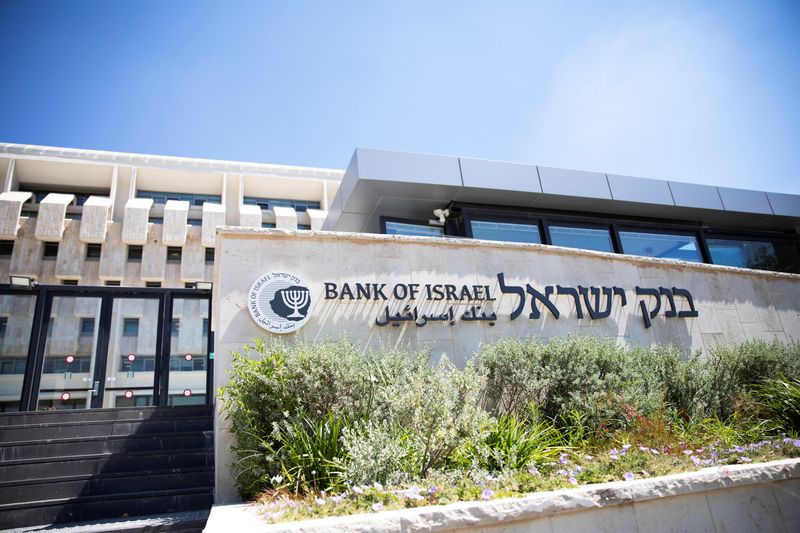By Libby George, Karin Strohecker and Steven Scheer
LONDON/JERUSALEM (Reuters) – Israel’s economy has endured for almost a year the chaos of a war that risks spiraling into regional conflict, but rising borrowing costs are beginning to strain its financial architecture.
The direct cost of financing the war in Gaza until August was 100 billion shekels ($26.3 billion), according to the Ministry of Finance. The Bank of Israel estimates that the total could rise to 250 billion shekels by the end of 2025, but that estimate was made before Israel’s incursion into Lebanon to fight Hezbollah, which will increase the tally.
This has led to credit rating downgrades, which are amplifying economic effects that could reverberate for years, while the cost of insuring Israel’s debt against default is near a 12-year high and its budget deficit is soaring. .
“As long as the war continues, sovereign debt indicators will continue to worsen,” said Sergey Dergachev, portfolio manager at Union Investment.
Although Israel’s debt-to-GDP ratio, a critical measure of economic health, stood at 62% last year, borrowing needs have skyrocketed.
“Even if Israel has a relatively good foundation, it will still be fiscally painful,” Dergachev said, adding: “And over time, it will put pressure on the rating.”
Israel’s finance minister has said the economy is strong and the country’s credit ratings should recover once the war ends.
The cost of war is high due to Israel’s Iron Dome air defenses, large-scale troop mobilization, and intense bombing campaigns. This year, the debt-to-GDP ratio reached 67%, while the public deficit is 8.3% of GDP, well above the 6.6% previously expected.
While the main buyers of Israel’s international bonds – pension funds or major asset managers attracted by its relatively high sovereign debt rating – are unlikely to offload the assets anytime soon, the investor base has shrunk.
Privately, investors say there is growing interest in dumping Israel’s bonds, or not buying them, due to concerns about the ESG implications of how the war is being conducted.
Norges Bank sold a small stake in Israeli government bonds in 2023 “given increased uncertainty in the market,” a spokesman for Norway’s sovereign wealth fund said.
“What you see reflecting these concerns are obviously valuations,” said Trang Nguyen, global head of emerging markets credit strategy at BNP Paribas, adding that Israeli bonds were trading at much wider spreads than those of similarly rated countries.
When asked about rising borrowing costs and investors’ ESG concerns for this story, Israel’s Finance Ministry did not immediately respond to a request for comment.
While Israel’s domestic bond market is deep, liquid and rapidly expanding, foreign investors have pulled out.
Central bank data shows the share held by non-residents fell to 8.4%, or NIS 55.5 billion, in July from 14.4%, or nearly NIS 80 billion, in September last year. During the same period, the number of bonds in circulation grew by more than a fifth.
“Israeli institutions are actually buying more over the last few months and I guess some global investors sold bonds because of geopolitics and uncertainty,” said a Finance Ministry official, who asked not to be identified.
Stock investors are also cutting back. Data from Copley Fund Research showed that international investors’ cuts to Israel funds, which began in May 2023 amid controversial judicial reforms, accelerated after the October 7 Hamas attacks.
Ownership of Israeli stocks by global funds is now at its lowest level in a decade.
Foreign direct investment in Israel fell 29% year-on-year in 2023, according to UNCTAD, the lowest since 2016. While figures for 2024 are not available, rating agencies have flagged the unpredictable impact of the war on these as worrying. investments.
All of this has amplified the need for local investment and government support.
In April, the government pledged $160 million in public money to boost venture capital funding for the crucial technology sector, which makes up about 20% of Israel’s economy.
This is on top of other costs, including housing thousands of people displaced by the fighting, many of them in empty hotels due to a sharp drop in tourists.
Displacements, labor shortages due to the mobilization, and Israel’s refusal to allow Palestinian workers in are hampering its agriculture and construction sectors.
The latter has been a key factor restraining economic growth, which plunged more than 20% in the fourth quarter of last year and has yet to recover. Data for the three months to the end of June show that seasonally adjusted GDP remained 1.5% below pre-attack levels, according to Goldman Sachs calculations.
So far, Israel has had few problems raising money. This year it sold about $8 billion of debt in international capital markets. Its diaspora bond vehicle, Israel Bonds, is aiming for a second annual record above $2.7 billion.
But rising borrowing costs loom, along with increased spending and economic pressure.
“There is room for Israel to continue to pull ahead, given a large domestic investor base that can continue to finance another sizeable deficit,” said Roger Mark, an analyst on Ninety One’s Fixed Income team.
“However, local investors expect at least some signs of consolidation efforts by the government.”
(1 dollar = 3.8055 shekels)
(Reporting by Libby George and Karin Strohecker in London and Steven Scheer in Jerusalem, editing by Alexander Smith and Christina Fincher)


